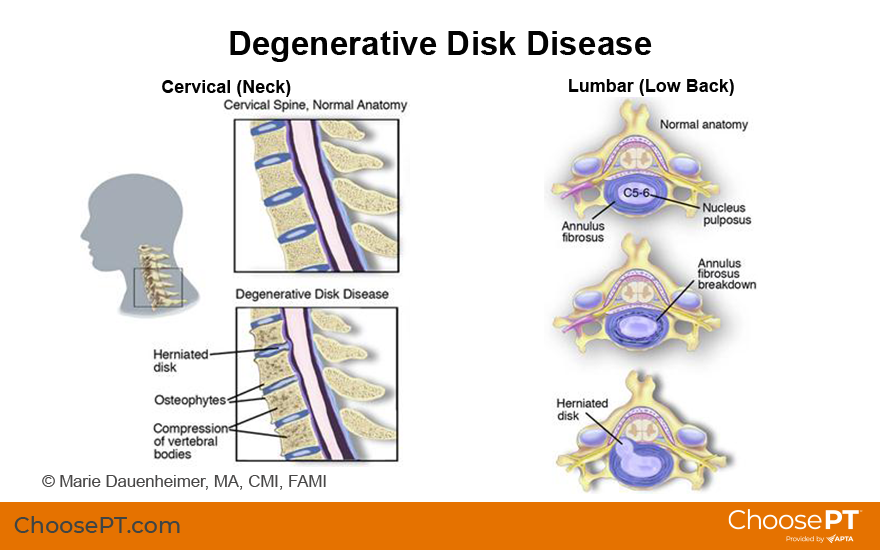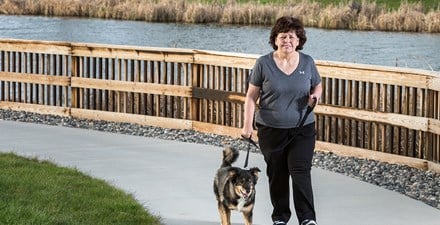Physical Therapy Guide to Degenerative Disk Disease
Degenerative disk disease, or disk degeneration, occurs when the disks that "cushion" the bones of the spinal column lose some of their thickness and flexibility. In many cases, it doesn't cause any pain. DDD is a natural part of aging, like getting gray hair. It is more common in older adults. DDD can lead to spine stiffness and back or neck pain in some people.
Up to 80% of people may experience back or neck pain at some point in their lives. The good news is that most people recover without needing surgery. Treatments such as physical therapy can be as effective as surgery for many types of back pain.
Regular exercise, and seeking medical advice when needed, can help keep your spine healthy and reduce the risk of pain and discomfort.
Physical therapists are movement experts. They improve quality of life through hands-on care, patient education, and prescribed movement. You can contact a physical therapist directly for an evaluation. To find a physical therapist in your area, visit Find a PT.
What Is Degenerative Disk Disease?
Degenerative disk disease is a common condition that can occur with aging. It's an expected change in the spine over time. While it can lead to occasional discomfort, most people with DDD continue to lead active and fulfilling lives.
The spinal column, or backbone, provides support, flexibility, and protection for our spinal cord. The spine is made up of a series of bones called vertebrae. Each vertebra "stacks" on top of another in a column-like structure spanning five regions:
- Cervical (neck).
- Thoracic (chest).
- Lumbar (lower back).
- Sacrum (the triangular bone located between the two hip bones). It stabilizes the pelvis).
- Coccyx (tailbone).
Between each vertebra are disks that function as shock absorbers and allow for smooth movement. Each disk has a tough outer layer (annulus fibrosus) and a gel-like inner core (nucleus pulposus).
Disks may gradually lose some thickness and flexibility, leading to degenerative disk disease. However, you can maintain a strong and flexible spine with proper care and healthy lifestyle choices. It is important to support the health of your spine and minimize potential discomfort by:
- Staying active.
- Practicing good posture.
- Engaging in exercises that strengthen your muscles.
You are more likely to develop DDD if you:
- Are obese.
- Smoke.
- Are physically inactive.
- Reach advanced age.

How Does It Feel?
With DDD, you may experience mild to intense neck and back pain — or no pain at all. If you do have pain, it will depend on where your spine is affected:
- An affected disk in the neck may cause arm, shoulder, or neck pain.
- An affected disk in the low back may cause pain in the back, buttocks, or legs.
It is important to note that how your spine looks doesn't always determine if you'll experience pain. Even if spinal changes occur, you might not feel any pain. Some people may only have slight or occasional discomfort.
It's reassuring to understand that having certain spinal changes doesn't automatically mean you'll have pain. Many factors can lead to or influence the feeling of pain, such as:
- Individual or nerve sensitivity.
- Inflammation.
- Your overall health.
If you have pain, health care professionals will check a variety of factors to find the cause. They also will develop treatment options for your specific needs.
Remember, there are many ways to manage and treat pain. Physical therapy can help you delay or avoid surgery and reduce the need for prescribed pain medications. It is also important to stay positive and work with your health care team to find the best solutions for you.
How Is It Diagnosed?
Your health care providers will consider three main components to make a diagnosis, including:
- Your medical history.
- Findings from a physical exam.
- Results from tests, including any diagnostic imaging.
Your physical therapist will conduct a thorough clinical evaluation. They will review your health history and use screening tools to determine the impact of DDD. Your physical therapist may:
- Ask questions about the specific location and behavior of your pain and other symptoms.
- Conduct tests of your muscle strength, coordination, and flexibility.
- Examine your posture and watch how you walk and do other activities.
- Measure the range of motion of your spine, arms, and legs.
- Use manual (hands-on) therapy to evaluate the mobility of the joints and muscles in your spine.
- Conduct a basic neurologic exam. This exam assesses your muscle strength, pain and numbness, and deep tendon reflexes.
Your physical therapist may work with your medical doctor if they find the following:
- Signs of progressive muscle weakness.
- Loss of feeling.
- Severe pain.
In such cases, diagnostic imaging tests (such as an X-ray or MRI) can help confirm a diagnosis. In some states, physical therapists can order these tests, but in others, your physician will.
It is often a relief when both a physical exam and diagnostic results align. However, considering all three criteria — health history, a clinical exam, and imaging — is essential for an accurate diagnosis.
How Can a Physical Therapist Help?
Studies show that 40% of people under age 30, and over 90% of those ages 50 to 55, have some disk degeneration. X-rays or MRIs may show normal, expected changes within your disks beginning around age 20. These changes may or may not even cause symptoms, so it’s important not to panic. Physical therapists can work closely with your other health care providers for an accurate diagnosis and provide treatment specific to you.
Research shows that in all but the most extreme DDD cases (usually involving muscle weakness or high pain levels), conservative treatments such as physical therapy have better results than surgery. Research also shows equal results after either conservative care or surgery (18 months after treatment). However, surgery can require a lengthy recovery and comes with other costs and risks.
Your physical therapist will perform a thorough evaluation. If they suspect you have DDD and have no major medical problems, treatment can begin right away.
The goal of physical therapy is to help you continue to take part in your daily activities and life roles. Your physical therapist will design a treatment program based on an evaluation and your goals. Your treatment program may include:
Stretching and flexibility exercises. Your physical therapist will teach you specific exercises to improve movement in the joints and muscles of your spine, arms, and legs. Improving motion in a joint is often the key to pain relief.
Strengthening exercises. Strong trunk muscles provide support for your spinal joints. Strong arm and leg muscles help take some of the workload off your spinal joints.
Aerobic exercise. Your physical therapist can work with you to find ways to achieve regular aerobic exercise. Activities such as walking, swimming, or low-impact aerobics have been shown to help manage DDD. The benefits of aerobic exercise include:
- Relieving pain.
- Promoting a healthy body weight.
- Improving overall strength and mobility.
A physical therapist can help you safely increase the amount of physical activity you can tolerate to improve your fitness. Research shows that the more exercise you can handle, the quicker you'll reduce your pain and other symptoms. Just being physically active can make a difference. Your physical therapist can review your interests, hobbies, and physical activity preferences and create a safe activity plan to help you achieve the recommended amount of physical activity.
Your treatment program also may include:
Manual therapy. Stiff joints and tight muscles may contribute to your symptoms. Your physical therapist may apply manual (hands-on) therapy treatments such as massage and joint mobilization to help improve movement.
Posture and body mechanics education. Your physical therapist may show you how to make small changes in how you sit, stand, bend, and lift. They also may help you adjust how you sleep. These changes can relieve your pain and help you manage your condition on your own.
Note: Studies show that neck and low back pain often returns if you do not receive proper treatment or follow your treatment plan. To lower the risk of recurrence, it's important to stick to the exercise plan your physical therapist makes for you. Be sure to do it regularly.
Can This Injury or Condition Be Prevented?
DDD is a natural result of aging. However, you can make choices that lessen its impact on your life and slow its progression. Your physical therapist can offer you advice on staying strong and fit. Some physical therapy clinics conduct seminars to help people learn how to take care of their backs and necks.
Your physical therapist can help you develop a fitness plan that takes your DDD into account. There are specific exercises that are better than others for people with DDD. Your physical therapist will choose the right ones for you. Following these research-backed recommendations can help you take control of your spinal well-being:
Trying physical therapy first. Research shows that physical therapy can improve quality of life, reduce pain, and help you return to daily activities. This can reduce any need for surgery.
Maintaining regular physical activity. Various types of activity and exercise may be beneficial for recovery and prevention. Exercising in water, weight training, or walking on level ground can help you stay active if other forms of exercise cause pain.
Reducing mechanical stress. Exercises involving repeated twisting and bending should be done with caution. If you start noticing pain after exercising, consult a physical therapist. They can improve how you move, adjust your exercises, and help reduce or eliminate your back or neck symptoms.
Addressing other factors. A person's behaviors, environment, genetics, and nutrition can affect spine health. Consult with a health care professional to get help addressing your specific needs. You can improve your overall health through lifestyle changes such as quitting smoking and avoiding weight gain.
What Kind of Physical Therapist Do I Need?
All physical therapists are prepared through education and experience to treat people who have DDD. You may want to consider:
- A physical therapist who is experienced in treating people with pain, orthopedic, or musculoskeletal (muscles, bones, and joints) diagnoses.
- A physical therapist who is a board-certified clinical specialist or who completed a residency or fellowship in orthopedic or geriatric physical therapy. This physical therapist has advanced knowledge, experience, and skills that may apply to your condition.
You can search for physical therapists in your area with these or other credentials by using Find a PT, a tool built by the American Physical Therapy Association.
General tips when you're looking for a physical therapist (or any other health care provider):
- Get recommendations from family, friends, or other health care providers.
- Ask about the physical therapists' experience in helping people with degenerative disk disease.
- Be prepared to describe your symptoms in as much detail as possible and say what makes your symptoms better or worse.
The American Physical Therapy Association believes that consumers should have access to information that can:
- Help them make health care decisions.
- Prepare them for a visit with their health care provider.
The following articles offer some of the best scientific evidence for the treatment of degenerative disk disease. The articles report recent research and give an overview of the standards of practice in the United States and internationally. The article titles link either to a PubMed* abstract of the article or to the free full text to read or bring with you to your health care provider.
Xin J, Wang Y, Zheng Z, et al. Treatment of intervertebral disc degeneration. Orthop Surg. 2022;14(7):1271–1280. Article Summary on PubMed.
Kos N, Gradisnik L, Velnar T. A brief review of the degenerative intervertebral disc disease. Med Arch. 2019;73(6):421–424. Article Summary on PubMed.
Fors M, Enthoven P, Abbott A, Öberg B. Effects of pre-surgery physiotherapy on walking ability and lower extremity strength in patients with degenerative lumbar spine disorder: secondary outcomes of the PREPARE randomised controlled trial. BMC Musculoskelet Disord. 2019;20(1):468. Article Summary on PubMed.
Macedo LG, Maher CG, Latimer J, McAuley JH. Motor control exercise for persistent, nonspecific low back pain: a systematic review. Phys Ther. 2009;89:9–25. Article Summary in PubMed.
Beattie PF. Current understanding of lumbar intervertebral disc degeneration: a review with emphasis upon etiology, pathophysiology, and lumbar magnetic resonance imaging findings. J Orthop Sports Phys Ther. 2008;38:329–340. Article Summary on PubMed.
Chou R, Qaseem A, Snow V, et al. Diagnosis and treatment of low back pain: a joint clinical practice guideline from the American College of Physicians and the American Pain Society [published correction appears in: Diagnosis and treatment of low back pain. Ann Intern Med. 2008]. Ann Intern Med. 2007;147:478–491. Article Summary on PubMed.
Roh JS, Teng AL, Yoo JU, et al. Degenerative disorders of the lumbar and cervical spine. Orthop Clin North Am. 2005:36:255–262. Article Summary on PubMed.
*PubMed is a free online resource developed by the National Center for Biotechnology Information. PubMed contains millions of citations to biomedical literature, including citations in the National Library of Medicine's MEDLINE database.
Expert Review:
Sep 9, 2023
Revised:
Sep 9, 2023
Content Type: Guide
Degenerative Disk Disease
PT, DPT
Timothy Nguyen
PT, DPT, Board-Certified Clinical Specialist in Geriatric Physical Therapy
You Might Also Like...
Health Tips
What Patients Should Know About Degenerative Disk DiseaseJan 28, 2020
Despite its name degenerative disk disease is not caused by a specific disease. Rather it is osteoarthritis of the spine, and a natural part of aging in
Patient Stories
Physical Therapy: Cyclist Overcomes Challenges to Scoliosis, Degenerative DiskNov 20, 2016
"She instilled it in me that I was going to get that 100% recovery—100% for me, not for the average person, but for me."
Patient Stories
Physical Therapy Helps Woman Recover From 3 Surgeries Over 13 YearsJul 29, 2015
"There is no doubt in my mind that without physical therapy, the quality of my life would be very different today."


